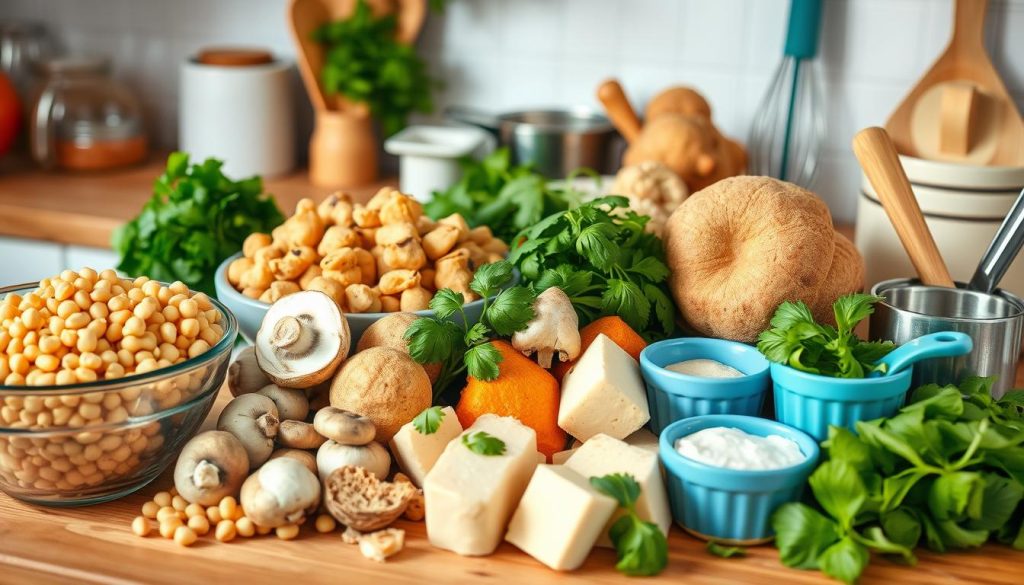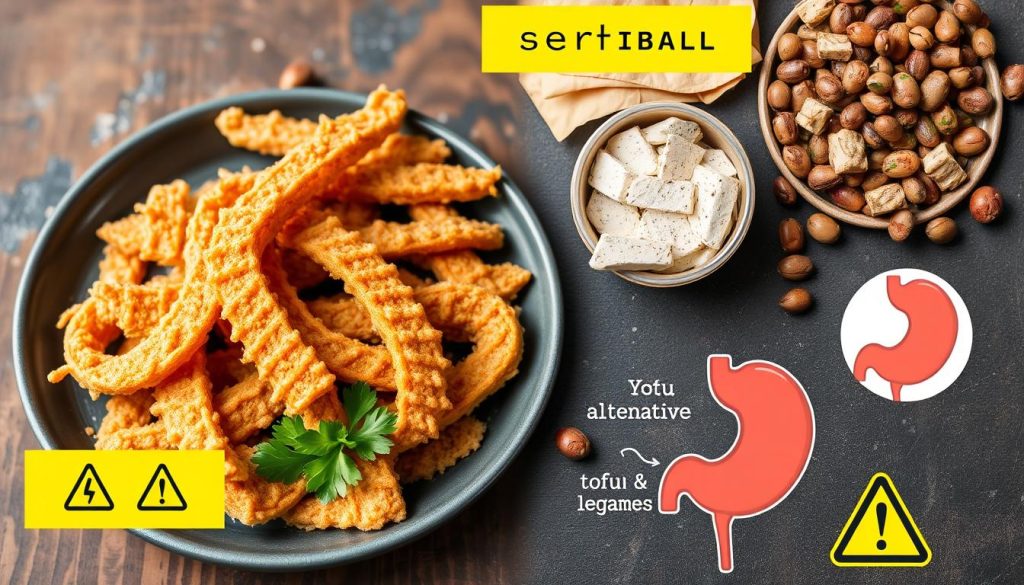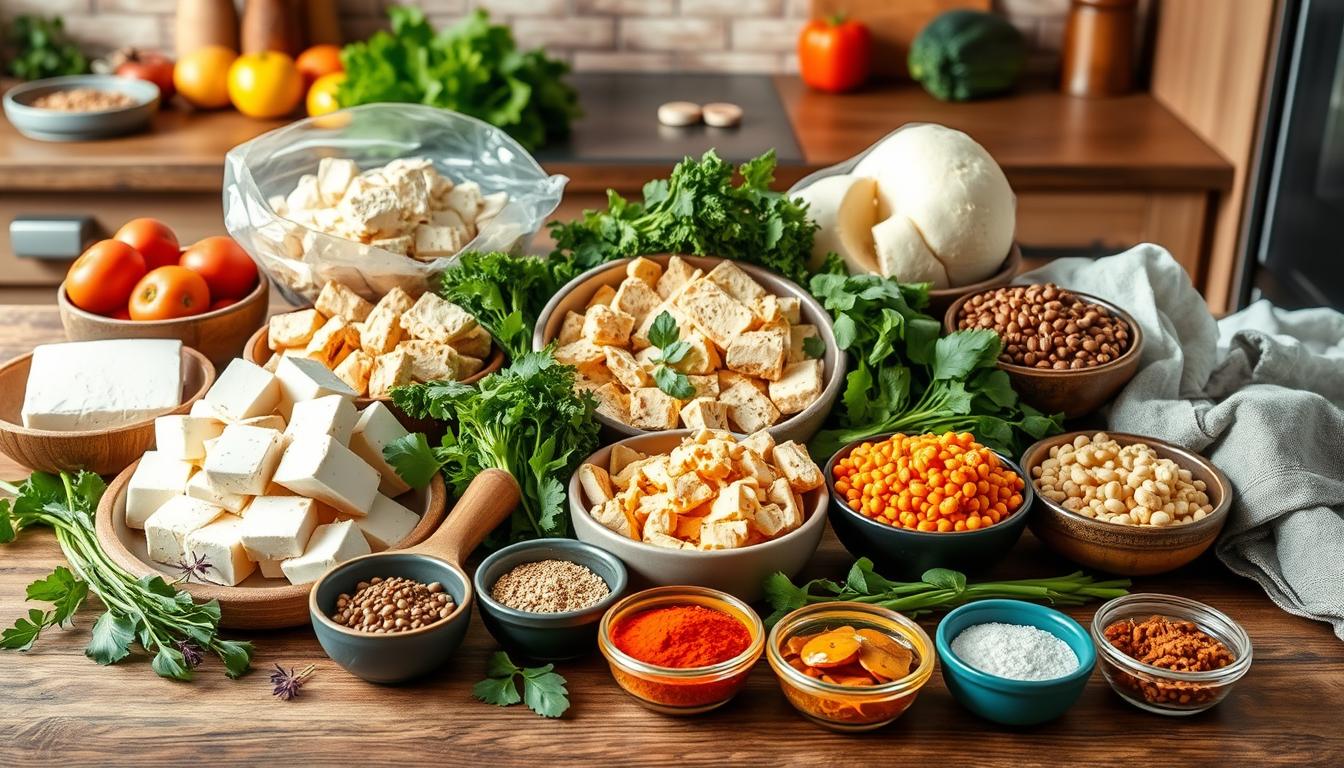Welcome to your ultimate seitan substitute guide. Here, you’ll learn about the versatility and benefits of this popular plant-based protein. Seitan, also known as “wheat meat,” is made from vital wheat gluten. It has about 21 grams of protein per 3-ounce serving, making it great for a healthy diet.
This guide will give you key information about seitan. You’ll learn about its health benefits and how to use it in your meals. As diets move towards more plant-based options, knowing about seitan helps you enjoy hearty, satisfying dishes while staying healthy.
What is Seitan and Why Use It?
Seitan is a meat substitute made from vital wheat gluten. It’s known for its chewy texture and is popular in plant-based diets. Its history dates back to ancient Asian cultures, like Chinese and Japanese traditions.
Understanding Seitan
Seitan has been a meat substitute for centuries, especially for Buddhist monks. It’s high in protein content, with about 20-21 grams per serving. It’s also low in fat and cholesterol, making it good for your heart.
Health Benefits of Seitan
Seitan offers more than just protein. It’s low in calories, with about 100 calories per 3-ounce serving. It also has iron, calcium, and phosphorus, which are good for your bones and blood. But, people with gluten sensitivities or celiac disease should avoid it.
| Nutritional Component | Value per 3-ounce Serving |
|---|---|
| Protein | 21 grams |
| Calories | 100 calories |
| Fat | Low |
| Cholesterol | 0 mg |
| Essential Minerals | Iron, Calcium, Phosphorus |
Exploring Alternatives to Seitan
Seitan is a great choice for those looking for meat alternatives. But, there are many other substitutes that are tasty and healthy. These options make it easy to eat more plant-based foods. Knowing about these alternatives can help you cook better.
What Are Common Meat Alternatives?
There are many popular meat alternatives. They help you stay on a plant-based diet while still enjoying tasty food. Here are some common ones:
- Tofu: Tofu has been a staple in China for over 2,000 years. It comes in different textures and absorbs flavors well, making it versatile for many dishes.
- Tempeh: This fermented soy product has a nutty taste and a firm texture. It’s great for grilling or stir-frying.
- Jackfruit: Jackfruit’s fibrous texture makes it a good substitute for pulled pork in savory dishes.
- Legumes: Legumes like chickpeas and lentils are high in protein and nutrients. They’re easy to add to many recipes.
Choosing the Right Substitute for Your Dish
When picking a vegan substitute, think about the dish’s flavor and cooking method. Tofu is great in stir-fries or soups because it absorbs flavors. Tempeh adds depth to salads and wraps with its texture. Jackfruit is perfect for dishes needing a meat-like texture. Legumes are great for stews or dips.
Using different plant-based options can make your meals more varied and nutritious. Many alternatives are rich in fiber, vitamins, and minerals. This can improve your health.
| Meat Alternatives | Flavor Profile | Best Uses |
|---|---|---|
| Tofu | Mild, adaptable | Stir-fries, soups, salads |
| Tempeh | Nutty, earthy | Grilling, sandwiches, sautés |
| Jackfruit | Sweet, fruity | Barbecue, tacos, curries |
| Legumes | Varied depending on type | Stews, dips, salads |
Trying out these substitutes can help you discover new recipes. It’s a step towards a healthier and more sustainable lifestyle.
Seitan Substitute Guide: Cooking Tips and Recipes
Adding seitan or its substitutes to your recipes can open up a world of flavors. Seitan is high in protein and great at soaking up flavors. Here are some tips and recipes to make your meals tasty and fulfilling.
How to Incorporate Substitutes in Your Recipes
Learning to cook seitan makes it a great addition to many dishes. Here are some tips to improve your cooking:
- Marinate the seitan in your favorite sauces or seasonings for several hours before cooking. This step boosts flavor significantly.
- Sauté seitan with vegetables to create a vibrant stir-fry that is not only colorful but satisfying.
- SimMER seitan in vegetable broth for about 30 minutes. This technique enriches its taste and gives it a hearty texture.
- Experiment with baking powder in your homemade seitan recipe. It contributes to a more tender bite.
Popular Recipes Using Seitan Substitutes
There are countless recipes that showcase seitan’s versatility. Here are some favorites:
- Vegan BBQ Ribs: A must-try for any barbecue lover, these fully-flavored ribs utilize seitan for a delicious twist.
- Seitan Stir-Fry: Combine seitan with a variety of colorful vegetables and a savory sauce for a quick weeknight meal.
- Hearty Stews: Seitan works well in stews, providing a satisfying protein boost that complements the rich flavors.
- Fajitas: Substitute seitan for beef, and enjoy a spicy, vibrant dish that will satisfy even non-vegans.

With these tips and recipes, using meat substitutes will become easy. Your cooking adventures with seitan are just beginning!
Potential Drawbacks of Using Seitan and Its Alternatives
Seitan is a meat substitute known for its protein. But, it has some downsides. It’s important to know these, especially if you have certain dietary needs.
Understanding Allergens and Sensitivities
Seitan, or wheat meat, is made from gluten. This makes it bad for people with gluten issues or celiac disease. They should stay away from it to stay healthy.
Some people might react to other ingredients in seitan. This is because many products have allergens. Always check the labels to avoid these.
Possible Nutritional Gaps
Seitan is high in protein but lacks some amino acids, like lysine. To get all amino acids, eat seitan with foods like legumes or quinoa. This makes a complete protein.
Some seitan products have a lot of sodium. This can be bad for your heart. Watch how much you eat to avoid too much sodium.

| Nutritional Aspect | Seitan (per 100g) | Complete Protein Sources (e.g., Quinoa) |
|---|---|---|
| Protein | 25-30g | 8g |
| Carbohydrates | Less than 10g | 21g |
| Fat | Less than 5g | 2g |
| Sodium | Varies (high in some products) | Low |
| Essential Amino Acids | Low | Complete |
Conclusion
In this guide, you’ve learned about seitan’s many benefits and uses. It’s a great choice for those looking for healthy meat alternatives. Seitan is high in protein and can be used in many different ways, making it perfect for plant-based diets.
Making seitan is easy thanks to vital wheat gluten. This makes it simple to add to your meals. You can try different ingredients to change its taste and texture.
Exploring seitan means trying new things. You can add coconut oil or whole wheat flour to make it taste better. You can also adjust cooking times and sizes to make it just right for you.
Seitan is good for those who want to eat plant-based, but remember about gluten. There are other options if you can’t have gluten. With the tips and recipes here, you can make tasty, healthy meals that fit your diet.
Source Links
- https://olivesfordinner.com/seitan-recipes/
- https://www.livestrong.com/article/13714658-tempeh-vs-tofu-vs-seitan-your-guide-to-meat-alternatives/
- https://www.bobsredmill.com/blog/healthy-living/how-to-make-seitan-from-scratch/
- https://www.veganfoodandliving.com/features/what-is-seitan/
- https://eatplant-based.com/what-is-seitan-how-to-cook-recipes/
- https://foodprint.org/blog/traditional-meat-alternatives/
- https://myshadeofgreen.com/vegan-meat-alternatives-a-complete-guide/
- https://shaneandsimple.com/how-to-make-seitan-at-home-easy-step-by-step-guide/
- https://theveganatlas.com/homemade-seitan-recipe/
- https://www.byrdie.com/is-seitan-bad-for-you-5074882
- https://www.clinikally.com/blogs/news/seitan-unveiled-nutritional-guide-advantages-risks-and-homemade-recipes?srsltid=AfmBOoqH_CMQCOO26o-frc5S2xBMOTKD0dDVAHcJGqV6iKB6Ygd5OfGM
- https://www.food-safety.com/articles/7674-safety-and-nutritional-risks-associated-with-plant-based-meat-alternatives
- https://blog.modernistpantry.com/advice/seitan/
- https://robertklineart.com/how-to-make-homemade-seitan/
